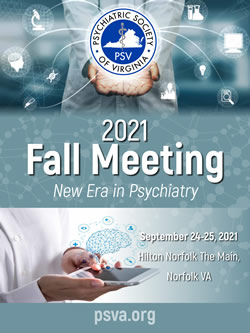Fall 2021 Issue |
|
|
|
A Trip to the Past: Psychedelics and Psychiatry
By Vivian Tran, DO and Stephanie Peglow, DO, MPH
 |
| Dr. Tran |
 |
| Dr. Peglow |
With increased awareness of the importance of mental health has come the realization that more effective treatments are needed for mental illness. Researchers and clinicians are now re-exploring a therapeutic avenue which has remained shrouded in mystery and legends for nearly one hundred years: psychedelics. Psychedelics in the context of mental health can be traced back to the early 1900s. German psychiatrist Emil Kraepelin and his pupils posited that psychiatric illness was rooted in genetic and biological dysfunction, which could be better understood by artificially reproducing psychoses. Thus, initial investigation into psychedelics began as an attempt to simulate the mental effects of psychiatric illness.
In 1923, mescaline was the first to be used as a “psychotomimetic” (psychosis-mimicking). Clinicians and scientists reported several common effects from psychotomimetic intoxication, which would later be explored as potentially therapeutic. Dr. E. Guttman suggested these substances were valuable in understanding synesthesia, experiencing mental effects such as those in patients with schizophrenia, and for therapeutic use in depersonalization states. Dr. GT Stockings recounted feelings of unreality and well-developed delusions which paralleled the symptoms reported by patients with schizophrenia (Nichols, 2020).
The next timestamp in the history of psychedelics occurred in 1943 when Swiss chemist Albert Hofmann inadvertently discovered the psychoactive effects of lysergic acid diethylamide (LSD-25). LSD-25 became available in 1947 under the trade name Delysid, which was indicated for experimental study into psychoses and as an adjunct to psychotherapy. Studies involving LSD-25 in subsequent years indicated its therapeutic potential in withdrawn patients, post-traumatic stress disorder (PTSD), substance use disorders (especially alcohol), and even anxiety in the terminally ill (Nichols, 2020). LSD research was brought to an abrupt halt in 1968, when possession and use of LSD was criminalized by the Drug Abuse Control Amendments (Reiff, 2020).
In 1970, with the Controlled Substances Act, LSD (and all other psychoactive drugs) ultimately became classified as Schedule I drugs, meaning they were deemed highly addictive with no currently accepted medical use. The passage of these laws, and subsequent end to psychedelic research, is often attributed to LSD’s booming popularity in the 1960s as a recreational drug by the countercultural movement. LSD became condemned and stigmatized as causing insanity (amongst other claims), and public opinion quickly turned on psychedelics (Gardner, 2019).
Although the majority of psychedelic research in that era focused on LSD-25, there were other psychoactive substances with therapeutic potential: psilocybin, MDMA (3,4-Methylenedioxymethamphetamine), DMT (N,N-dimethyltryptamine), and ketamine. Psilocybin had long been used in ceremonies among natives in Central and South America, but only came under scientific investigation in the 1960s. Its ability to induce euphoria, auditory and visual hallucinations, and feelings of existential wholeness made psilocybin a promising adjunct therapy in palliative care, psychotherapy, mood disorders, and substance use disorders.
The first study truly dedicated to the therapeutic potential of psychedelics occurred in 2006, when researchers gave psilocybin to patients with obsessive-compulsive disorder (OCD) (Nichols, 2020). There has been a resurgence of interest in psychedelics since then, with many current clinical trials involving psilocybin and psychiatric illnesses such as alcohol dependence, OCD, and mood disorders related to terminal illness. Most notably, the FDA designated psilocybin as a breakthrough therapy for treatment-resistant depression in 2018 (Reiff, 2020).
MDMA was initially synthesized in 1912 as a potential agent to prevent hemorrhaging, which proved unfruitful, but its psychoactive properties were unknown until 1978. In the early 1980s, MDMA gained popularity as a recreational drug and became illegally distributed and used under the street name Ecstasy. Due to this, the Drug Enforcement Administration (DEA) emergently classified MDMA as a Schedule I substance in the late 1980s. The renewed interest in MDMA, spurred along by general interest in psychedelics, is likely also due to the increasing concern over PTSD in veterans and first responders. As of 2017, MDMA has been classified as a breakthrough therapy as an adjunct treatment for PTSD. MDMA is also currently in clinical trials as a potential therapy for social anxiety disorder in individuals with autism spectrum disorder (Reiff, 2020).
DMT, the psychoactive component of the decoction Ayahuasca, has long been used by indigenous peoples of the Amazon region for its hallucinogenic properties. Although it is a psychoactive substance of recent interest in treating depression, DMT’s clinical potential remains unexplored due to its Schedule I classification (Reiff, 2020). Ketamine is often considered outside of the “classic psychedelics” and has seen more clinical use than the other psychoactives discussed above. It has been used medically as an anesthetic since 1970 but was recently approved in 2019 for use in treatment-resistant depression (Kohtala, 2021). Of the psychoactive drugs named above, only ketamine is classified as a Schedule III substance (which describes a drug with potential for abuse and an accepted medical use) (Doblin, 2019).
Although the stigma surrounding psychedelics still exists, much has changed since the early 1900s. There are two psychedelics now in Phase 3 clinical trials and approved as breakthrough therapies for mental health illnesses: MDMA-assisted therapy for treatment-resistant PTSD, and psilocybin for treatment-resistant depression (Doblin, 2019). The use of psychedelics is certainly not without its dangers, which makes the need even greater for more research and clinical studies. In reviewing the history of psychedelics there is a very strong argument for the untapped therapeutic potential of psychoactive substances in psychiatry. The era of psychedelics in mental health has undeniably come again, this time with the added advantages of greater understanding of the importance of mental health, the neurobiology of psychiatric illnesses, and the need for effective treatments.
References
- Doblin, R. E., Christiansen, M., Jerome, L., & Burge, B. (2019). The past and future of psychedelic science: An introduction to this issue. Journal of Psychoactive Drugs, 51(2), 93–97. https://doi.org/10.1080/02791072.2019.1606472
- Gardner, J., Carter, A., O’Brien, K., & Seear, K. (2019). Psychedelic-assisted therapies: The past, and the need to move forward responsibly. Internat
- Kohtala, S. (2021). Ketamine—50 years in use: From anesthesia to rapid antidepressant effects and neurobiological mechanisms. Pharmacological Reports, 73(2), 323–345. https://doi.org/10.1007/s43440-021-00232-4
- Nichols, D. E., & Walter, H. (2020). The history of psychedelics in psychiatry. Pharmacopsychiatry, 54(04), 151–166. https://doi.org/10.1055/a-1310-3990
- Reiff, C. M., Richman, E. E., Nemeroff, C. B., Carpenter, L. L., Widge, A. S., Rodriguez, C. I., Kalin, N. H., & McDonald, W. M. (2020). Psychedelics and psychedelic-assisted psychotherapy. American Journal of Psychiatry, 177(5), 391–410. https://doi.org/10.1176/appi.ajp.2019.19010035
YOUR NEWSLETTER IS NOW AVAILABLE ON YOUR SMARTPHONE AND TABLET!
JOIN PSV TODAY!
REGISTER TODAY!
PSV 2021
FALL MEETING
September 24-25, 2021
Hilton
Norfolk The Main
Norfolk, VA
APA Find a Psychiatrist
Are you accepting new patients?
Opt into APA’s Find A Psychiatrist database. To view the functionality or opt-in,
CLICK HERE
FYI: A link for this option has been added to the PSV website. Select the About button and then Find a Psychiatrist from the drop down.



